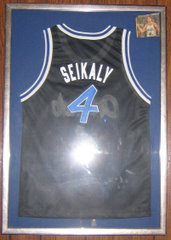One week ago today, I made a post in which I wrote that Keyon Dooling should start at point guard for the Magic if the team went with a defense-oriented starting lineup. My reasoning came from objectively watching Dooling play; he's the best defender the Magic have under 6'6" tall. He also played minutes at point guard down the stretch last season as Carlos Arroyo fell out of favor with Brian Hill.
All the recent discussion about the validity of statistics in the basketblogosphere got me thinking, "How would that defensive-oriented lineup change if I were to use statistics instead of my own knowledge about the players?" I’ll go into two possibilities in that regard momentarily.
The statistics discussion began over at Plissken at the Buzzer, where Carter Blanchard poo-pooed John Hollinger's Player Efficiency Rating (PER) because it rated the likes of Brent Barry and Earl Boykins more highly than it rated Lamar Odom. Tom Ziller of Sactown Royalty responded in this post on Ballhype, and the discussion has spun-off into so many posts on so many blogs that it’s hard to keep them straight.
I personally put a fair amount of trust in PER because it
- Compiles a player's offensive and defensive statistics into one number,
- Adjusts that number for playing-time and league pace, and
- Normalizes that number to 15 each season; that is, a marginal player will have a PER below 15 and a good player will have a PER above 15.
Using data from
the incomparable 82games, here is what the Magic's best defensive lineup would be, derived from subtracting the PER a player allows opponents he is guarding from a player’s own PER:
- Carlos Arroyo (15.6 own, 14.3 allowed, +1.3)
- Keyon Dooling (11.2 own, 13.4 allowed -2.2)
- Rashard Lewis (21.6 own, 15.5 allowed, +6.1)
- Tony Battie (10.3 own, 15.2 allowed, -4.9)
- Dwight Howard (23 own, 12.9 allowed +10.1)
Notice that Dooling and Battie allow better PERs than they post themselves. What’s sad is that those two players were, by this measure, the best at their respective positions last season even with those negative differences.
However, this lineup only works if you trust PER and 82games' assessment of each player's position; according to that site, for instance, Dooling was on the floor for 35% of the Magic's total minutes last season, and he spent 88.5% of that time at shooting guard. The table,
available here, is reproduced in image form below:

But a statistical system in which Lamar Odom (15.9 points per game, 9.8 rebounds per game, 4.8 assists per game in 2006/2007; 16.1 PER) is rated lower than Brent Barry (8.5 points per game, 2.1 rebounds per game, 1.8 assists per game in 2006/2007; 16.6 PER) surely must be flawed, right? After all, players who rarely get off the bench do not have a fair amount of data from which to draw their PERs, which is why our very own James Augustine (a total of 7 minutes played in two games last season) posted a PER of 16.6, which also exceeds Lamar Odom's showing.
Perhaps a better indicator of a player's defensive effectiveness is his plus/minus rating, adjusted on a per-100 possessions basis. For instance, the Magic allowed 106.1 points per 100 possessions when Dwight Howard was on the floor, but just 105.4 points per 100 possessions when he was off it. Using this information, we can see that, at least last season, the Magic were actually a slightly better defensive team when Howard was not in the game.
Here's how the all-defense lineup looks when using on-court/off-court defensive performance as the criterion. Note that a negative differential is good because it means the team allows fewer points per 100 possessions when the player is on the floor:
- Carlos Arroyo (103.8 on, 106.9 off, -3.1)
- Keith Bogans (105.7 on, 106.0 off, -0.3)
- Trevor Ariza (103.1 on, 107.2 off, -4.1)
- Tony Battie (103.4 on, 107.5 off, -4.1)
- Dwight Howard (106.1 on, 105.4 off, +0.7)
Interesting how Keith Bogans and Trevor Ariza show up here, but not in the previous list. This indicates, at least to me, that Bogans and Ariza are better team defenders than they are individual defenders.
Even more interesting: Dooling’s per-100 possession defensive differential isn’t so great; when he is on the floor, the Magic allow 108.1 points per 100 possessions. But when he’s off the floor, the Magic’s defense is better, allowing 104.6 points per 100 possessions. I have no idea how to explain that. Even more puzzling is Jameer Nelson’s numbers. When he’s on the floor, the Magic allow 107.1 points per 100 possessions. Does that mean that Jameer is a better defender than Keyon is? It seems to indicate that fact is true, although we, as Magic fans, know it not to be.
I now pose the question to you: if you had to select a defensive-oriented starting lineup for the Magic, whom would you choose?
This discussion of statistics has left me tired; I need to shut my brain off, and perhaps you do too. For you, then, I present
Hedo Turkoglu getting dunked on by Marco Belinelli in Eurobasket competition. No wonder Turk doesn't appear on any of these defensive lineups, although, in fairness, he was the weak-side defender on the play and was not responsible for Belinelli getting into the lane.
Thanks to Tom Ziller for originally posting that clip over at AOL Fanhouse.



















